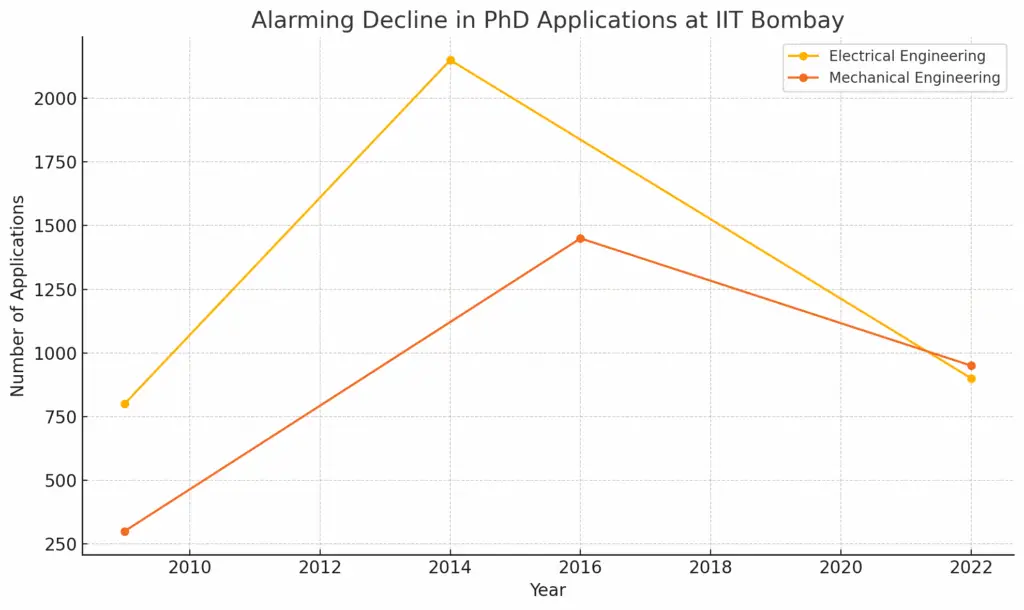In recent years, the Indian Institutes of Technology (IITs), renowned for their excellence in engineering and technology education, have witnessed a significant drop in PhD applications. A working paper by Professor D. Manjunath from IIT Bombay highlights this concerning trend, prompting a deeper examination of the factors contributing to this decline and the implications for India’s research landscape.
The Alarming Decline in PhD Applications
Professor Manjunath’s paper, titled “Engineering PhDs in Premier Institutions: What’s the Slope?”, reveals a sharp decrease in PhD applications across core engineering disciplines such as mechanical, chemical, and electrical engineering. For instance, among the examples cited in the paper is that of IIT Bombay itself, where, in the field of electrical engineering, the total number of applications for PhD courses was 800 in 2009, peaked at 2,150 in 2014, and then witnessed a significant drop to 900 in 2022. Similarly, for mechanical engineering, the total number of applications for 2009 was 300, shooting up to 1,450 in 2016, and then dropping to 950 in 2022.

This downward trend isn’t isolated to IIT Bombay. Institutions like IIT Madras, IIT Gandhinagar, and IISc Bengaluru have reported similar declines, indicating a broader issue within India’s premier research institutions.
Unpacking the Causes: The Rise and Fall of PhD in India
Several factors contribute to this decline:
- Attraction to Overseas Opportunities: Many students opt for PhD programs abroad, drawn by better research facilities, funding, and global exposure.
- Lucrative Government Jobs: The acceptance of GATE scores by Public Sector Undertakings (PSUs) for recruitment has made government jobs more accessible and appealing, diverting potential PhD candidates.
- Declining Quality of Master’s Programs: The paper points out that many Master’s programs, traditionally feeders for PhD courses, are facing challenges. High attrition rates and concerns about program quality deter students from pursuing further research.
- Limited Post-Doctoral Opportunities: The Indian tech industry offers limited roles for PhD holders, making the long academic journey less enticing than immediate employment opportunities.
Implications for India’s Research Ecosystem
The decline in PhD applications at IITs has far-reaching consequences:
- Reduced Research Output: Fewer PhD candidates mean less research, hindering innovation and technological advancement.
- Brain Drain: Talented students seeking better opportunities abroad contribute to the loss of intellectual capital.
- Stagnation in Academia: A decrease in doctoral scholars can lead to a shortage of qualified faculty, affecting the quality of education and mentorship.
Charting a Path Forward
To address this crisis, a multi-pronged approach is essential:
- Enhance Master’s Programs: Revamping curricula, improving faculty quality, and providing better support can make these programs more robust and appealing.
- Strengthen Industry-Academia Collaboration: Creating more research opportunities within industries can provide practical applications for PhD research and increase job prospects.
- Promote Research Culture: Institutions should actively promote the value of research through seminars, workshops, and collaborations, especially targeting undergraduate students.
- Increase Funding and Support: Providing adequate financial support and resources can make PhD programs more accessible and less burdensome.
10-Point Action Plan to Improve PhD Enrollments in India
1. Revamp Research Funding Policies
- Provide attractive fellowships with inflation-adjusted stipends.
- Introduce performance-based top-up grants and bonuses for quality publications.
2. Launch a National PhD Awareness Campaign
- Conduct outreach in Tier 2 and Tier 3 colleges to raise awareness about the benefits of pursuing a PhD.
- Use social media and digital platforms to highlight success stories.
3. Create Industry-Integrated PhD Programs
- Partner with industries to offer joint research programs, internships, and funded projects.
- Offer job placement support after graduation to assure better ROI.
4. Restructure Entrance and Admission Processes
- Simplify and standardize the PhD admission process across IITs and other institutions.
- Recognize diverse academic backgrounds and allow interdisciplinary research.
5. Improve Master’s Degree Quality
- Make M.Tech and M.S. programs more research-oriented.
- Introduce mini-thesis and project-based assessments to inspire early research interest.
6. Ensure Clear Career Pathways Post-PhD
- Develop post-doctoral fellowships, research scientist roles, and academic tenure-track positions.
- Collaborate with the private sector for R&D-based employment pipelines.
7. Incentivize Research Mentorship
- Provide incentives and awards to professors for mentoring PhD students effectively.
- Encourage co-guidance with international experts and alumni.
8. Strengthen Research Infrastructure
- Invest in labs, libraries, and high-end research tools.
- Ensure access to global journals, databases, and software tools.
9. Support Mental Health and Work-Life Balance
- Establish counseling centers and stress management workshops for PhD students.
- Create a supportive academic culture that values both productivity and well-being.
10. Recognize and Celebrate Research Contributions
- Publicly recognize outstanding PhD theses, early-career researchers, and impactful discoveries.
- Create national research awards and fellowships for young scholars.
The declining trend in PhD applications at IITs is a clarion call for introspection and action. By understanding the underlying causes and implementing strategic reforms, India can reinvigorate its research ecosystem, ensuring that its premier institutions continue to be beacons of innovation and excellence.

